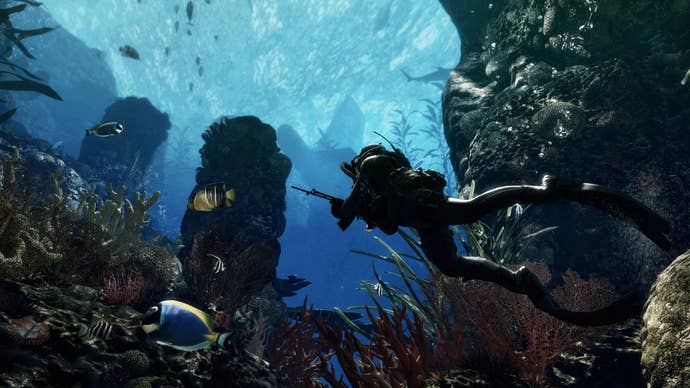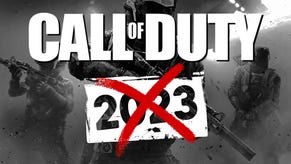When It's OK to Say "It's Like Call of Duty"
Developers could do well to borrow ideas from Infinity Ward... if it's the right idea.
This article first appeared on USgamer, a partner publication of VG247. Some content, such as this article, has been migrated to VG247 for posterity after USgamer's closure - but it has not been edited or further vetted by the VG247 team.
We walked away from E3 2013 with two clichés ringing in our ears: "It's open world," and "We've looked to Call of Duty for inspiration."
The former could make for some interesting games; open-world design doesn't automatically make a game great, but some of the most engrossing titles in recent years -- including Grand Theft Auto, Skyrim, Saints Row, Crackdown, Dark Souls -- have taken a sandbox approach to design. We're bound to see quite a few that make a hash of the concept, but anything that pushes game design in the opposite direction of Ryse: Son of Rome and its notorious self-completing quick-time events will be a welcome sight for many.
The trend of chasing Call of Duty, on the other hand, won't end as well. Historically, it never goes well. Every game that tries to imitate Activision's biggest property inevitably goes down in flames. The creators of Final Fantasy XIII once told me they looked to Call of Duty for inspiration; turns out they meant they had dropped any form of exploration or freedom to create a linear, scripted, story-driven RPG. Fans hated it. Electronic Arts rebooted the Medal of Honor series to be more like Call of Duty; it tanked. DICE chased Call of Duty for Battlefield 3's campaign mode, and players rejected the results. Halo 4 added a number of Call of Duty-like elements to its multiplayer systems, all of which went over poorly with fans.

You can certainly understand the impulse to copy Call of Duty; its popularity verges on unbelievability, with each installment of the series selling more than 20 million copies worldwide each year. The industry has never seen such a consistent, high-volume success story. But grasping hold of that success isn't as simple as dissecting Infinity Ward's work and borrowing the best elements piecemeal; the series works because of the way its individual components come together in unison.
Be that as it may, the rest of the industry could do well to learn from the tech behind the Xbox One version of Call of Duty: Ghosts, specifically a feature Infinity Ward refers to as "Sub-D rendering." Amidst all the outrage directed at Xbox One's online requirements and the mockery directed at Ghosts' addition of a dog to the cast, the discussion of Sub-D rendering seems to have been pushed to the side. Nevertheless, I feel like it represents something meaningful: A big studio trying to find ways to keep costs manageable through clever application of technology.
Yesterday, USgamer boss Jaz Rignall linked to an interesting Variety article focusing on Hollywood's summer blockbuster bloodbath, as a number of big-budget films have failed spectacularly this year, just like they did last year, just as they did the year before. As with the gaming industry, Hollywood budgets continue to balloon; studios continue to play it safe; and audiences find themselves unmoved by the uncreative bloat on display. The upcoming generation of consoles brings with it the potential for even greater cost inflation, as higher-spec systems demand more detailed visuals. Even in the PlayStation 2 generation, graphics could account for as much as 90% of a game's development resources, and countless developers have driven themselves out of business by trying to stay at the cutting edge of the current gen. Pretty graphics cost a lot to create, and these days only a handful of studios can afford to try. The next generation will only make things worse.

That's what makes Ghosts' Xbox One version so interesting. No, it is not -- as many people have pointed out -- the best-looking next-gen game on offer. But that seems to be by design. Infinity Ward is still targeting the current-gen consoles with Ghosts; after all, if you want to sell another 20 million copies, you need to go where the people are. The idea behind Sub-D rendering is to reduce the manpower required to bring a current-gen title to next-gen platforms through automation. It allows the CPU to automatically enhance polygonal models, adding more detail to characters and smoothing geometric shapes like gun sights from jagged blocks to smooth circles. It's a form of interpolation, in other words, allowing developers to create assets at the industry's current standard and leaving the computer to fill in the details.
While this doesn't make for the absolute best-looking graphics, you can definitely see a difference in quality between the graphics in Ghosts versus last year's Black Ops II. And frankly, the reality of next-gen consoles is that they won't offer the vast leaps in visual quality we're accustomed to from generational transitions; most of the improvements we see will come from improved lighting and shaders. And even if Xbox One and PlayStation 4 did offer the power to produce massively more detailed visuals, the simple fact of the matter is that the games industry wouldn't have the resources to make effective use of that added power anyway.
Tricks like Sub-D rendering should play a significant role in the coming generation. Granted, it doesn't put Ghosts anywhere near the cutting edge of gaming visuals, but it's a decent first attempt. I suspect -- I hope -- these tricks and shortcuts will become a standard part of every developer's tool set over the next few years. The fact that the people behind the single best-selling franchise currently on the market are trying to come up with ways ways to keep their resource demands from ballooning out of control should tell you everything you need to know about just how unreasonable budgets could become in the coming generation -- especially in light of this newfound obsession with open-world game design. The past generation has amounted to a depressing hellscape of studio closures, budget overruns, and craven conservatism of design for fear of alienating a single potential customer. I, for one, would prefer an industry in better health.

.jpg?width=291&height=164&fit=crop&quality=80&format=jpg&auto=webp)


_ziVC6Lw.jpg?width=291&height=164&fit=crop&quality=80&format=jpg&auto=webp)

.jpg?width=291&height=164&fit=crop&quality=80&format=jpg&auto=webp)

